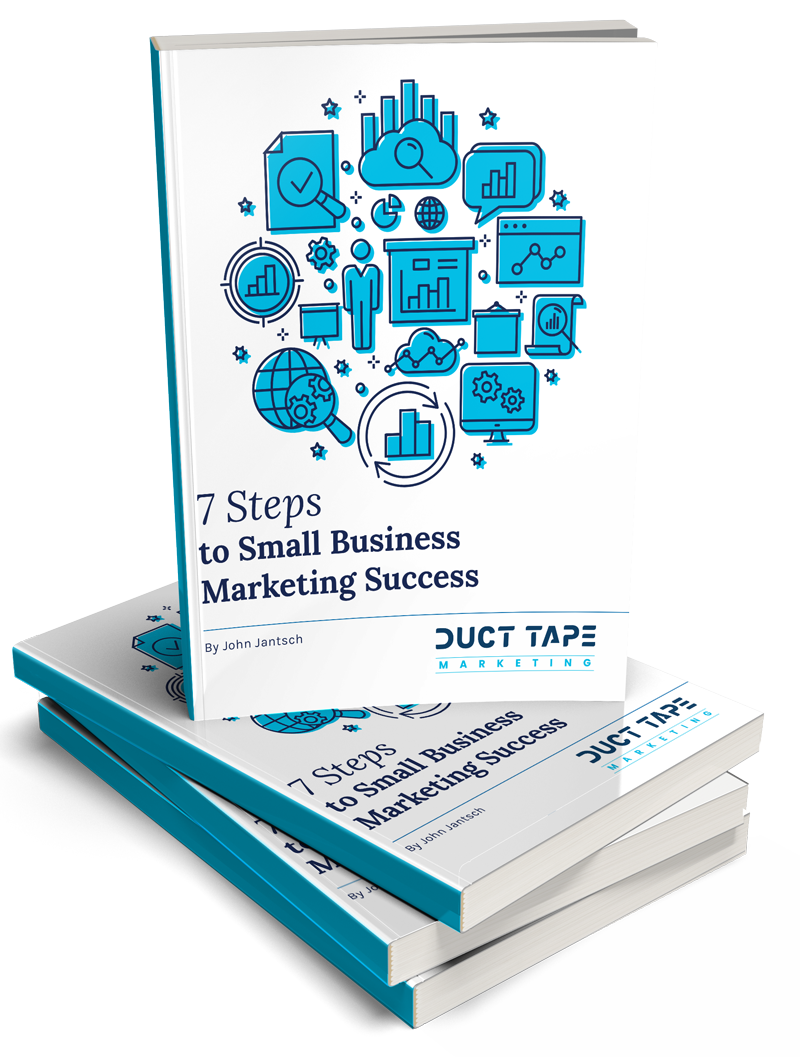Transcript
John Jantsch: More than anything else, I think that the way people buy is driving the changes in marketing today. In fact, that’s the biggest change is the buyer’s journey. We have entered, I believe, into something that people are calling the engagement economy and this week’s episode of The Duct Tape Marketing Podcast I visit with Karen Steele, the VP of Marketing for Marketo. They have just completed a giant survey of over 2,000 marketers and consumers and have produced something called The State of Engagement, and you’re going to want to check this out.
Hello, and welcome to another episode of The Duct Tape Marketing podcast. This is John Jantsch and my guest today is Karen Steele. She is the Vice President of Corporate Marketing for the marketing automation software provider, Marketo. We’re going to talk about some of the findings from what, I think, is a somewhat massive undertaking that takes the form of an eBook called The State of Engagement: Insights on Engagement from 2000 Global Consumers and Marketers. So Karen, thanks for joining me.
Karen Steele: Thank you, John. Happy to be here.
John Jantsch: So this might sound like a silly question but I think that the term engagement gets tossed around so much these days, that maybe we ought to try to get a baseline definition. What is engagement in the context of this research?
Karen Steele: It’s a great starting question. So when we think about engagement we really think engagement is the new meaning for marketing. We think that today consumers don’t want to be marketed to. I think they feel like with all the new technologies that marketing is pretty passive. They want to be understood. They want to be communicated with at the time that they want to hear a particular message through the channel that they want it from. And so engagement is about combining all of those things, the right insights about the person you’re talking to, the right channel about how to reach them, sort of the personal touch and the connection through every single point of a lifecycle of the journey of the customer. So we believe that the philosophy behind engagement is that it’s the new marketing. It’s really the new way of doing marketing, and it’s called engagement.
John Jantsch: Okay, we’d better break that down and make it practical because that was a lovely global definition. But I’m sure a lot of people are already starting to say, “Well okay, yeah, how do I do that?” So let’s start with, what’s the most common way that consumers engage today? Is it Twitter support, asking for it? Is that the first place to enter?
Karen Steele: You know, that’s certainly … I think that’s more of a post sale, I suppose, and that’s one opportunity. I think that ordinarily the first place, whether you’re a B to B business or a B to C business, is you’re going to engage through a company’s website. You’re going to come to a website. You’re going to be searching for information, and, by the way, you expect that information to be very relevant to you. You expect the message … That is, if I’m a particular type of a buyer, I want a message that’s directed toward me. So typically, the first place that you’re going to engage, on the consumer’s side, is the company’s website.
John Jantsch: Okay, so a great … I’ve been talking about marketing forever, and a lot of people have … Talking about all the changes in marketing. You could suggest that this engagement economy is a major shift in marketing, but are we really talking about the way that people buy as the thing that’s changed?
Karen Steele: Oh, I think it’s most certainly how people buy and how people go about qualifying vendors. I think today, before people even come to a decision process in any kind of a purchase, they’ve typically done a fair amount of research, whether it’s through reading articles in the press or going to a company’s website or looking at a company’s Facebook page, for example. They’ve done a lot of that and formed opinions before they even make a purchase with you.
Today, the buyer is more informed than ever, and the channels where they can find information are at their fingertips. I do think the process of buying, in the first place, and selling to consumers has changed a lot. And then, the way that marketers now can actually engage with consumers is completely changed, because of all the various channels. I mean, you mentioned Twitter with a support question if I own a product in the post sales world. That’s just another example, but there are certainly many, many others.
John Jantsch: So one of the real challenges, I think a lot of website owners face today, is that their website has to do a lot of jobs. I mean, it’s not just there to tell somebody how to contact them. It might actually … Its first job might be to teach somebody what their problem actually is. How do you figure out the journey and the different objectives and different goals that a website visitor might have, and how do you serve up for the needs of all of those?
Karen Steele: That’s such a great point. It used to be that websites were brochureware. In fact, in the olden days, when we first started seeing every company have a www address, it was exactly that. Companies took a corporate brochure and turned it into an HTML page that … Nowadays, the reality is that it’s all about creating experiences and being very specific to the type of buyer or prospect that is going to come to your website. I think understanding how to deliver a personalized message and move people through your funnel, whatever that funnel is, depending on the complexity of the product that you have … Offering demos, for example, just being one click away from learning more about the product or a click away from hearing a customer video, somebody like you in your industry talking about how they’ve had success with a particular product or, in our case, technology.
I think any company today that’s building a website has to think about what their objectives are, and I would say it’s about personalized relevant conversations and ultimately an experience through a digital set of pages that take people through the journey and the journey of learning and the journey of the marketer listening as somebody is browsing the webpage and then serving up the right content to move them along that journey.
John Jantsch: So in your experience, where inside of an organization does engagement go to die?
Karen Steele: Oh wow. Well, I think it … Engagement goes to die inside of an organization that doesn’t think about the customer journey first. And I think that if you’re a customer centered organization, you may think you’re doing a great job of engagement, I challenge you to go take a look at really how you’re doing, but I think it really doesn’t exist if you have an organization that doesn’t value and think about the customer first and how important it is, to talk in that customer’s language, and to put messages forward that they’re going to care about.
John Jantsch: Well, I’ll probably get myself in trouble here but my experience over many, many years of doing this and looking at organizations and really working on the customer journey is the handoff between sales and whatever service is or delivery or implementation. It seems to be [crosstalk 00:08:01] where the experience has the biggest gap.
Karen Steele: Yeah, I think that’s accurate. I think that you know it’s sort of the old adage that, you know, sales people go in and they close the deal and they hand it off and they’re done and they’re onto the next deal. So, who really owns that relationship [crosstalk 00:08:23] you know, does marketing own the entire experience? I mean … I think we have a pretty good chance to. I don’t think that exists in all organizations today, but I think that the marketer is in the best position to think about the entire experience and all the engagement points through the cycle. They don’t own all of those, you know, touch points per se … Because as you said there’s a pre-sales, there’s a sales, there’s a buying experience, there the support organization etc.,[crosstalk 00:08:53] but I think marketing we’ve certainty seen it happen for our customers is in probably the best position to influence the entire customer journey and experience. So engagement doesn’t go somewhere to die in the organization.
John Jantsch: You know I would suggest this gets kind of cliché to say, but there’s sort of a culture element to engagement … Isn’t there?
Karen Steele: There is absolutely … You hit the nail right on the head. There is a fundamental cultural issue to engagement because it starts with understanding your customer, or your prospect, or your partner, or your employee. And really figuring out, what the best way to talk to them, and how you’re gonna connect them to your brand, or your story, or your message, or your offer. And culturally it has to be part of the DNA of the company. You have to be thinking about relationships and not just thinking about transactions. I gotta get an email out … I gotta put a cross[inaudible 00:09:58] campaign out the door. You have to be thinking about, “I want to extend the value of my relationship with this customer.” Or this partner. It is fundamental in the way that the organization thinks about engagement as a whole, but also the customer journey.
John Jantsch: In your experience what are the key difference between B to B and B to C engagement?
Karen Steele: It’s really the channels more than anything. I think B to B has historically, and I think we have some data, I know we have some data in the report that talks about the primary channels … Being websites and email and that’s certainly very true in the B to B world I think you get in the B to C world and you see a lot more social engagement and you see a lot more mobile engagement. This has to do with just the nature of the business and what people are buying. I think all sides B to B and B to C need to optimize for all channels, you just need to have a careful strategy about when and where to use each channel. Testing is obviously great we believe in putting things out there see how they do, tweaking messages, personalizing always, and seeing what lands and what kind of results you get.
John Jantsch: Some of the things that have become … I don’t necessarily like this terminology, but we all understand it. Some of the things that are becoming kind of top of the funnel things like blogging and podcasting … Don’t really have much engagement, typically anymore. Especially most people turning commenting off even on a lot of blogs and things, but we still all preach those as being important channels. How could you drive more engagement in the top of the funnel? Or is it even necessary.
Karen Steele: Oh I think it’s most definitely necessary. I think engagement is up and down the funnel. The example you just gave of blogs, I think it’s how you use the blogs. If the blogs are a static message that you post somewhere and expect people will come to it. That’s pretty passive engagement. If you’re using elements of the blog and picking up quotes and driving in using that in social and driving people to it, you can create other conversations and dialogue around the blog. The blog should not be seen as in the same way … A webpage shouldn’t be seen … As sort of a standalone thing that’s supposed to drive engagement. It’s all the things you do around it and all the interconnections of all the various channels and messages.
John Jantsch: What other areas I really see a lot of companies fall off … And it’s not because they don’t realize the value of focusing here, but in the area of retention and how much engagement really leads to loyalty and referrals and maybe it could actually take away you’re entire need to go out and generate new leads.
Karen Steele: Well, you know, we have a particular point of view that I would love to talk about … Whether you call it retention or advocacy that I’m pretty passionate about. We have a program called purple select. And purple select … This is exactly what it sounds like, it’s a group of self selected people that want to be treated in a certain way by Marketo. And we’ve built a number of offerings for them, it’s a combination of social and gamification to reward them for certain activities, so it’s kind of a quid pro quo. We want a reference from you or we want a story from you, but we want to do thing on your behalf as well. And help our customers become hero’s. So there’s ways of engaging that are programmatic that drive at loyalty, that drive at advocacy, that connect customers to your business in a way that you won’t get through other channels. We have, I think, 1,800 people in our customers in our purple select program right now and they engage every single day.
John Jantsch: So is that program on your website anywhere that we could send people?
Karen Steele: It is a separate link, I think we have information on the website, but I’d be happy to follow up with the URL. [crosstalk 00:14:06]. I don’t have it in front of me.
John Jantsch: And we’ll put it in the show notes when you send it to us so people will [crosstalk 00:14:12] be able to go to that. So, tell me a little bit about where people … I actually am a little old school still and I print some of these things out … Where they can get the … I think I got up to about 80 pages of the full report of the state of engagement. We have barely scratched the surface.
Karen Steele: Indeed. I think it’s 80 pages long. Incredibly comprehensive. As you stated at the onset, it was a combination of qualitative and quantitative interviews, some 2,000 from around the world. You can download that directly from the Marketo website at www.marketo.com. And it’s also available in other places, our partners are distributing it, but the best place to go is marketo.com.
John Jantsch: Awesome. Well Karen, thanks for joining us and sharing some insights on engagement and go grab that report because there’s some incredible data, charts, graphs. Pretty much anything that you’re wondering about engagement, can be found in there. So, thanks again Karen.
Karen Steele: Awesome. Thank you John.
John Jantsch: Hey thanks for listening to this episode of The Duct Tape Marketing podcast. I wonder if you can do me a favor … Could you leave an honest review on iTunes. Your ratings and review really help, and I promise I read each and every one. Thanks.



